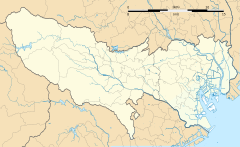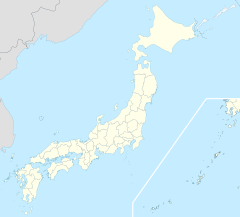railroad.wikisort.org - Station
Kanda Station (神田駅, Kanda-eki) is a railway station in Chiyoda, Tokyo, Japan. East Japan Railway Company (JR East) and Tokyo Metro operate individual portions of the station.
KNDJK27JY02JC02 G13 Kanda Station 神田駅 | ||||||||||||||||||||||||||||||||||||||||||||||||
|---|---|---|---|---|---|---|---|---|---|---|---|---|---|---|---|---|---|---|---|---|---|---|---|---|---|---|---|---|---|---|---|---|---|---|---|---|---|---|---|---|---|---|---|---|---|---|---|---|
 The north entrance in May 2021 | ||||||||||||||||||||||||||||||||||||||||||||||||
| General information | ||||||||||||||||||||||||||||||||||||||||||||||||
| Location | 2-13-1 Kajichō, Chiyoda-ku, Tokyo Japan | |||||||||||||||||||||||||||||||||||||||||||||||
| Operated by |
| |||||||||||||||||||||||||||||||||||||||||||||||
| Line(s) |
| |||||||||||||||||||||||||||||||||||||||||||||||
| Other information | ||||||||||||||||||||||||||||||||||||||||||||||||
| Station code |
| |||||||||||||||||||||||||||||||||||||||||||||||
| History | ||||||||||||||||||||||||||||||||||||||||||||||||
| Opened | March 1, 1919 | |||||||||||||||||||||||||||||||||||||||||||||||
| Other services | ||||||||||||||||||||||||||||||||||||||||||||||||
| ||||||||||||||||||||||||||||||||||||||||||||||||
| Location | ||||||||||||||||||||||||||||||||||||||||||||||||
Lines
- JR East
- Keihin-Tōhoku Line
- Yamanote Line
- Chūō Line (Rapid)
- Tokyo Metro
- Tokyo Metro Ginza Line
Station layout
Kanda consists of two separate stations that form an interchange. The elevated station is operated by JR East and the underground station is operated by the Tokyo Metro. Although they are an interchange, passengers must pass through ticket barriers and pay separate fares to switch between services.
JR East station
The JR East station is the older of the two stations and opened in 1919. It is situated on an elevated viaduct and has three island platforms serving six tracks.[1] The platforms are numbered sequentially from east to west starting with platform 1. Yamanote Line trains use the inner platforms 2 and 3, Keihin-Tōhoku Line trains use platforms 1 and 4, and Chūō Line trains use platforms 5 and 6 as they split off from the main line north of Kanda.[1] There are an additional two tracks east of the station; these are used for Shinkansen trains running between Tokyo Station and Ueno.
There are two sets of entrances and exits (a total of four) that allow passengers to access the JR East station. The northern set, the north and east exits, offers a connection to the Ginza Line on the Tokyo Metro. The southern set, the south and west exits, has a View Plaza travel service centre. Both exits have rows of ticket machines, ticket gates, and a JR reservation office.[1]
| 1 | JK Keihin-Tōhoku Line | for Shinagawa, Yokohama, and Ōfuna |
| 2 | JY Yamanote Line | for Tokyo and Shinagawa |
| 3 | JY Yamanote Line | for Ueno and Ikebukuro |
| 4 | JK Keihin-Tōhoku Line | for Ueno, Akabane, and Ōmiya |
| 5 | JC Chūō Line | for Tokyo |
| 6 | JC Chūō Line | for Ochanomizu, Shinjuku, and Takao |
- Ticket gates at the south and west exits
- The south entrance
- The west entrance
 Yamanote Line (left) and Keihin-Tōhoku Line (right) platform screen doors, 2021
Yamanote Line (left) and Keihin-Tōhoku Line (right) platform screen doors, 2021
Tokyo Metro
The Tokyo Metro station is the newer of the two stations and opened in 1931 as part of an extension of first subway line in Asia, the Ginza Line. There is a simple island platform setup with two tracks. Platform 1 is for southbound trains to Ginza and Shibuya whilst platform 2 is used for northbound trains to Ueno and Asakusa.
Access to the station is provided by a total of six entrances and exits. Exits and 1 and 2 are used as the connection to the JR East station and are on Chūō-dōri (中央通り). Exits 3 and 4 are on the same street but in the centre of the station near Kanda-Kajichō. Exits 5 and 6 are at the northernmost part of the station.
| 1 | G Tokyo Metro Ginza Line | for Ginza and Shibuya |
| 2 | G Tokyo Metro Ginza Line | for Ueno and Asakusa |
The song "Omatsuri Mambo" (お祭りマンボ, Omatsuri Mambo) by Hibari Misora is used as the departure melody for the Ginza Line platforms in 2015.[2]
- Row of ticket machines and fare table
- Platforms, August 2018
History
The station first opened on March 1, 1919 when the Chūō Main Line was extended from Manseibashi Station, which existed between Kanda and Ochanomizu, to Tokyo Station.[3]
The tracks of Tōhoku Main Line, now used by trains on the Keihin-Tōhoku Line and the Yamanote Line, extended from Akihabara Station to Kanda and further to Tokyo on November 1, 1925.[4] This extension completed the loop of the Yamanote Line.
The subway station opened on November 21, 1931. On this day, the subway closed the temporary terminal at Manseibashi Station and made Kanda Station the new terminus. The station became an intermediate station on April 29, 1932 when the line was extended to Mitsukoshimae Station.[5]
The station facilities of the Ginza Line were inherited by Tokyo Metro after the privatization of the Teito Rapid Transit Authority (TRTA) in 2004.[6]
The extension through Kanda Station of the Tōhoku Shinkansen from its previous terminus at Ueno to Tokyo breached a pair of express tracks of the Tohoku Main Line through the station.[citation needed] These are being reinstated by the Tōhoku Jūkan Line project. The project was due to be completed in 2013 but was subsequently delayed until 2015 as a result of the 2011 Tōhoku earthquake and tsunami.[7][8][9]
From March 14, 2015 onwards, Keihin-Tōhoku rapid services began serving the station.[10]
Passenger statistics
In fiscal 2013, the JR East station was used by an average of 97,589 passengers daily (boarding passengers only), making it the fortieth-busiest station operated by JR East.[11] In fiscal 2013, the Tokyo Metro station was used by an average of 52,612 passengers per day (exiting and entering passengers), making it the seventieth-busiest station operated by Tokyo Metro.[12] The average daily passenger figures for each operator in previous years are as shown below.
| Fiscal year | JR East | Tokyo Metro |
|---|---|---|
| 2000 | 111,311[13] | |
| 2005 | 105,782[14] | |
| 2010 | 101,075[15] | |
| 2011 | 99,307[16] | 49,410[17] |
| 2012 | 97,779[18] | 52,247[19] |
| 2013 | 97,589[11] | 52,612[12] |
- Note that JR East figures are for boarding passengers only.
See also
References
- Kanda station map JR East Retrieved 19 January 2009
- "2015年ニュースリリース|東京メトロ". www.tokyometro.jp. 14 May 2015. Retrieved 12 June 2021.
{{cite web}}: CS1 maint: url-status (link) - Ishino, Tetsu; et al., eds. (1998). 停車場変遷大事典 国鉄・JR編 [Station Transition Directory – JNR/JR] (in Japanese). Vol. II. Tokyo: JTB Corporation. p. 173. ISBN 4-533-02980-9.
- Ishino, supra, p. 387, vol. II
- "開業の経過 (Tokyo Metro)" (in Japanese). Retrieved 2008-11-22.
- "「営団地下鉄」から「東京メトロ」へ" [From "Teito Rapid Transit Authority" to "Tokyo Metro"]. Tokyo Metro Online. 2006-07-08. Archived from the original on 16 May 2012. Retrieved 29 May 2022.
- An Interview with the President on JR East website, retrieved 2009-05-13
- JR East Annual report 2007 on JR East website, retrieved 2009-05-13
- JR東日本:東京−上野の新線 愛称を「上野東京ライン」 [JR East names new line between Tokyo and Ueno "Ueno-Tokyo Line"]. Mainichi Shimbun (in Japanese). Japan: The Mainichi Newspapers. Archived from the original on 2013-12-09. Retrieved 15 September 2014.
- "2015年3月 ダイヤ改正について" [Information regarding the March 2015 timetable amendment] (PDF). East Japan Railway Company. 19 December 2014. p. 10. Retrieved 16 April 2015.
- 各駅の乗車人員 (2013年度) [Station passenger figures (Fiscal 2013)] (in Japanese). Japan: East Japan Railway Company. Archived from the original on 6 May 2001. Retrieved 15 September 2014.
- 各駅の乗降人員ランキング [Station usage ranking] (in Japanese). Tokyo Metro. Retrieved 15 September 2014.
- 各駅の乗車人員 (2000年度) [Station passenger figures (Fiscal 2000)] (in Japanese). Japan: East Japan Railway Company. Archived from the original on 9 October 2014. Retrieved 15 September 2014.
- 各駅の乗車人員 (2005年度) [Station passenger figures (Fiscal 2005)] (in Japanese). Japan: East Japan Railway Company. Archived from the original on 9 October 2014. Retrieved 15 September 2014.
- 各駅の乗車人員 (2010年度) [Station passenger figures (Fiscal 2010)] (in Japanese). Japan: East Japan Railway Company. Archived from the original on 6 October 2014. Retrieved 15 September 2014.
- 各駅の乗車人員 (2011年度) [Station passenger figures (Fiscal 2011)] (in Japanese). Japan: East Japan Railway Company. Archived from the original on 8 October 2014. Retrieved 2 September 2014.
- 駅別乗降人員順位表(2011年度1日平均) [Station passenger figures (Fiscal 2011)] (in Japanese). Japan: Tokyo Metro. Retrieved 15 September 2014.
- 各駅の乗車人員 (2012年度) [Station passenger figures (Fiscal 2012)] (in Japanese). Japan: East Japan Railway Company. Archived from the original on 7 October 2014. Retrieved 15 September 2014.
- 各駅の乗降人員ランキング (2012年) [Station usage ranking (2012)] (in Japanese). Tokyo Metro. Retrieved 15 September 2014.
External links
- Kanda Station information (JR East) (in Japanese)
- Kanda Station information (Tokyo Metro) (in Japanese)
На других языках
[de] Bahnhof Kanda
Der Bahnhof Kanda (jap. 神田駅, Kanda-eki) ist ein Bahnhof in der japanischen Hauptstadt Tokio, der von den Bahngesellschaften JR East und Toei bedient wird. Er befindet sich im Nordosten des Bezirks Chiyoda und ist ein Umsteigeknoten zwischen Eisenbahn und U-Bahn.- [en] Kanda Station (Tokyo)
[ru] Канда (станция, Токио)
Станция Канда (яп. 神田駅 канда эки) — железнодорожная станция на линиях Яманотэ, Кэйхин-Тохоку, Тюо (Скорая) и Гиндза, расположенная в специальном районе Тюо, Токио. Станция обозначена номером G-13 на линии Гиндза. На станции установлены автоматические платформенные ворота.Другой контент может иметь иную лицензию. Перед использованием материалов сайта WikiSort.org внимательно изучите правила лицензирования конкретных элементов наполнения сайта.
WikiSort.org - проект по пересортировке и дополнению контента Википедии









